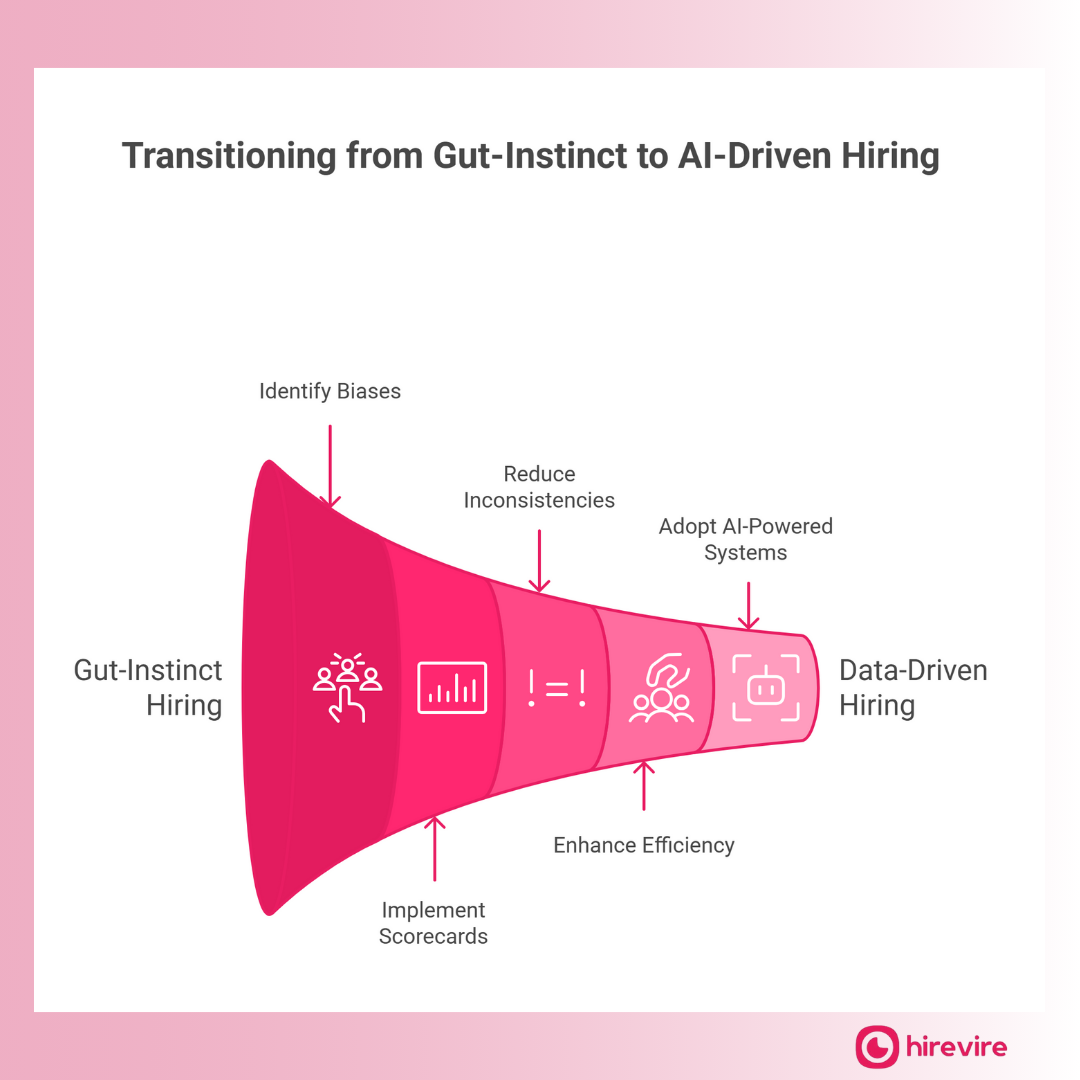Summary:
Relying on gut instincts for hiring decisions is prevalent but risky, leading to biased and inconsistent recruitment outcomes. Transitioning to structured candidate scorecards, enhanced by AI, offers a solution by providing objective, data-driven evaluations. AI-powered systems like Hirevire streamline the process, ensuring fair, efficient, and scalable assessments, ultimately improving hiring quality and reducing bias.
Table of Contents
The Shocking Reality of Gut-Instinct Hiring
The True Cost of Biased Hiring Decisions
Enter the Candidate Scorecard Solution
What is a Candidate Scorecard?
Core Components of an Effective Candidate Scorecard
Traditional Paper vs. Modern Digital Evolution
The Video Interview Revolution
Why Specialized Video Scorecards Matter
The Foundation for Modern Fair Hiring
The Purpose of Interview Scorecards : Structured Interview process
Primary Purpose: Eliminating Bias and Ensuring Objectivity
Consistency Across Interviewers and Interview Questions
Legal Compliance and Protection
Team Alignment and Collaborative Decision-Making
Data-Driven Decisions Over Gut Feelings
The Modern Challenge: Volume and Complexity In Providing Interview Feedback
Candidate Scorecard Templates & Examples
Basic Interview Scorecard Template
Role-Specific Scorecard Examples
Resume Screening Scorecard Template
Video Response Evaluation Templates
Traditional Scorecards vs. AI-Powered Scoring
Limitations of Manual Scoring Systems
The Volume Challenge in Modern Recruitment
The AI Revolution in Candidate Evaluation
Hirevire's AI Review Process Deep Dive
How Hirevire Transforms Candidate Scoring
Automated AI Reviews for Video and Audio Responses
Key Focus Areas: Comprehensive Response Analysis
Custom Evaluation Criteria: Tailored Scoring Framework
Match/Non-Match Insights with Detailed Reasoning
Bulk Processing: Scale Without Compromise
Implementation Guide: Setting Up Fair Candidate Scoring
Step-by-Step Scorecard Creation
Best Practices for Bias Reduction
Hirevire Workflow: From Video Creation to AI Scoring
Future Developments in AI Evaluation
Hirevire Roadmap: Expanding AI Capabilities
Transform Your Candidate Evaluation Today
What is the difference between a candidate scorecard and a regular interview evaluation?
How do candidate scorecards help reduce hiring bias?
Can candidate scorecards be customized for different roles?
How long does it take to implement candidate scorecards?
What's the ROI of using structured candidate scorecards?
How do AI-powered scorecards compare to manual evaluation?
Are candidate scorecards legally compliant for hiring decisions?
"I have a really good feeling about this candidate," the hiring manager announced after a brief phone screening. It's a phrase heard in boardrooms worldwide, yet it represents one of the most dangerous decision-making approaches in modern recruitment.
The Shocking Reality of Gut-Instinct Hiring
Here's the uncomfortable truth: between 85% and 97% of hiring decisions are still based on gut feelings rather than objective evaluation criteria* This statistic isn't just alarming—it's a direct threat to building diverse, high-performing teams and avoiding costly legal complications.
When recruiters rely on intuition over structured assessment, they're essentially gambling with their company's future. The human brain, despite its remarkable capabilities, is hardwired with unconscious biases that cloud judgment during candidate evaluation.
The True Cost of Biased Hiring Decisions
Poor hiring decisions cost far more than most organizations realize:
- Financial Impact: According to SHRM research, a single bad hire can cost up to five times an employee's annual salary when factoring in training, lost productivity, and replacement costs
- Time Drain: HR managers currently spend 30-40% of their work week on initial screening calls, often following repetitive patterns that fail to predict job performance
- Legal Risks: Inconsistent evaluation processes expose companies to discrimination claims and compliance violations
- Cultural Damage: Bad hires disrupt team dynamics and can damage employer brand when candidates share negative experiences
The Consistency Crisis
Without standardized evaluation methods, organizations face a cascade of problems:
Different interviewers assess candidates using varying criteria, making it impossible to compare applicants fairly. A LinkedIn survey revealed that 57% of talent professionals struggle to assess soft skills accurately during traditional interviews, while 42% worry about interviewer bias affecting outcomes.
Teams struggle to justify hiring decisions with data, leading to second-guessing and prolonged decision-making processes that often lose top candidates to faster-moving competitors.
Enter the Candidate Scorecard Solution
The most successful organizations have moved beyond gut feelings to implement candidate scorecards—structured evaluation tools that create consistency, reduce bias, and provide defensible hiring decisions.
But here's where it gets interesting: traditional paper-based scorecards are rapidly becoming obsolete in our digital-first world. The future belongs to AI-powered evaluation systems that can process video responses, analyze communication patterns, and provide objective scoring at scale.
Modern platforms like Hirevire are revolutionizing how companies evaluate candidates by combining the structure of traditional scorecards with the power of artificial intelligence, creating a new standard for fair and efficient hiring.
Ready to transform your hiring process from guesswork to data-driven decisions?
What is a Candidate Scorecard?
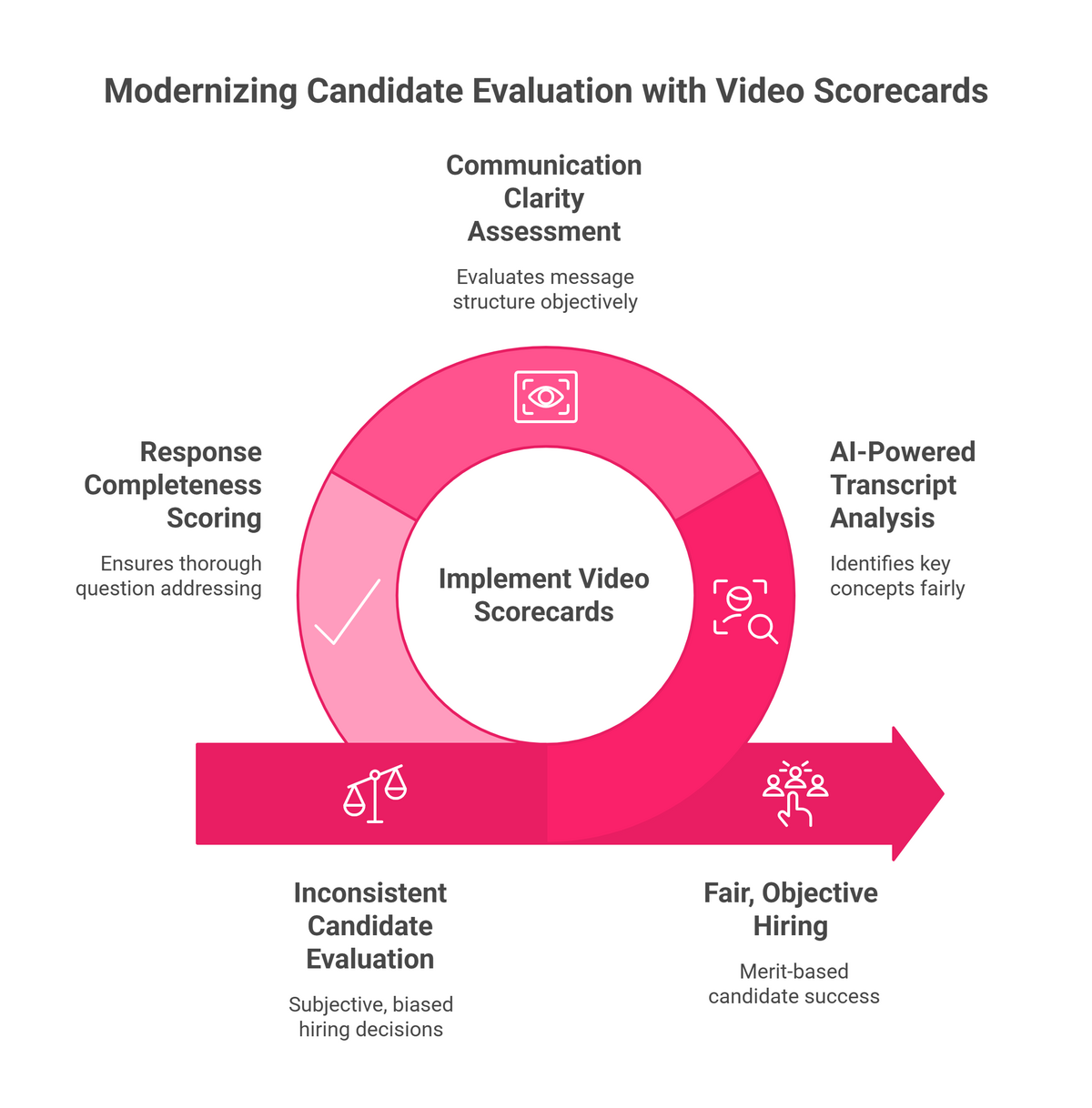
A candidate scorecard is a structured evaluation tool that transforms subjective hiring decisions into objective, data-driven assessments. Think of it as your hiring team's North Star—a standardized framework that ensures every candidate receives fair evaluation based on predetermined criteria rather than interviewer mood, personal preferences, or unconscious bias.
Core Components of an Effective Candidate Scorecard
Every well-designed candidate scorecard includes these fundamental elements:
Job-Relevant Competencies: Specific skills, knowledge areas, and abilities directly tied to role success. Rather than vague categories like "good communicator," effective scorecards define measurable criteria such as "clearly articulates complex technical concepts to non-technical stakeholders."
Rating Scales: Consistent numerical or descriptive scales (typically 1-5 or 1-10) that allow evaluators to score candidate performance objectively. Each scale point should have clear definitions to prevent interpretation variations.
Weighted Criteria: Not all skills carry equal importance. A software developer scorecard might weight technical problem-solving at 40% while communication skills receive 20%, reflecting actual job requirements.
Evidence-Based Scoring: Space for specific examples and observations that justify each rating, creating accountability and enabling useful feedback for candidates.
Traditional Paper vs. Modern Digital Evolution
The candidate scorecard concept isn't new—recruiters have used basic evaluation forms for decades. However, traditional paper-based approaches suffer from significant limitations:
- Manual compilation of scores across multiple interviewers
- Inconsistent application of criteria
- Difficulty sharing and comparing candidate evaluations
- Time-intensive documentation processes
- Limited ability to track scoring patterns or identify bias
Digital scorecards represent a massive improvement, enabling real-time collaboration, automated calculations, and data analytics that reveal hiring patterns. But even standard digital forms fall short when dealing with modern recruitment challenges.
The Video Interview Revolution
Here's where traditional scorecards hit a wall: they were designed for live, in-person conversations. Today's hiring landscape demands something entirely different.
With remote work becoming standard and global talent pools expanding, asynchronous video interviews have emerged as the preferred screening method. Candidates record responses on their own time, eliminating scheduling nightmares while providing richer information than phone calls or resume reviews.
But this shift creates new scorecard requirements:
- Multi-format evaluation: Scoring video responses requires different criteria than live conversations
- Consistency at scale: When reviewing dozens of video responses, human evaluators struggle to maintain consistent standards
- Technical considerations: Audio quality, video clarity, and technical difficulties can unfairly impact traditional scoring
Why Specialized Video Scorecards Matter
Platforms like Hirevire have recognized this gap, developing specialized evaluation frameworks designed specifically for asynchronous video responses. These systems go beyond traditional scorecards by incorporating:
AI-powered transcript analysis that identifies key concepts and keywords regardless of accent or speaking style, ensuring non-native speakers receive fair evaluation across the platform's 90+ supported languages.
Communication clarity assessment that evaluates message structure and coherence without penalizing candidates for technical issues or nervousness that might affect live interviews.
Response completeness scoring that ensures candidates fully address questions while accommodating different communication styles and cultural backgrounds.
The Foundation for Modern Fair Hiring
What makes a candidate scorecard truly effective isn't just its structure—it's how consistently and fairly it gets applied. The best scorecards create a level playing field where candidates succeed based on merit rather than interviewer preferences or communication style similarities.
Traditional scorecards laid important groundwork by introducing structure to hiring decisions. However, the future belongs to intelligent evaluation systems that combine human insight with technological capabilities, ensuring every candidate receives the thorough, unbiased assessment they deserve.
The Purpose of Interview Scorecards : Structured Interview process
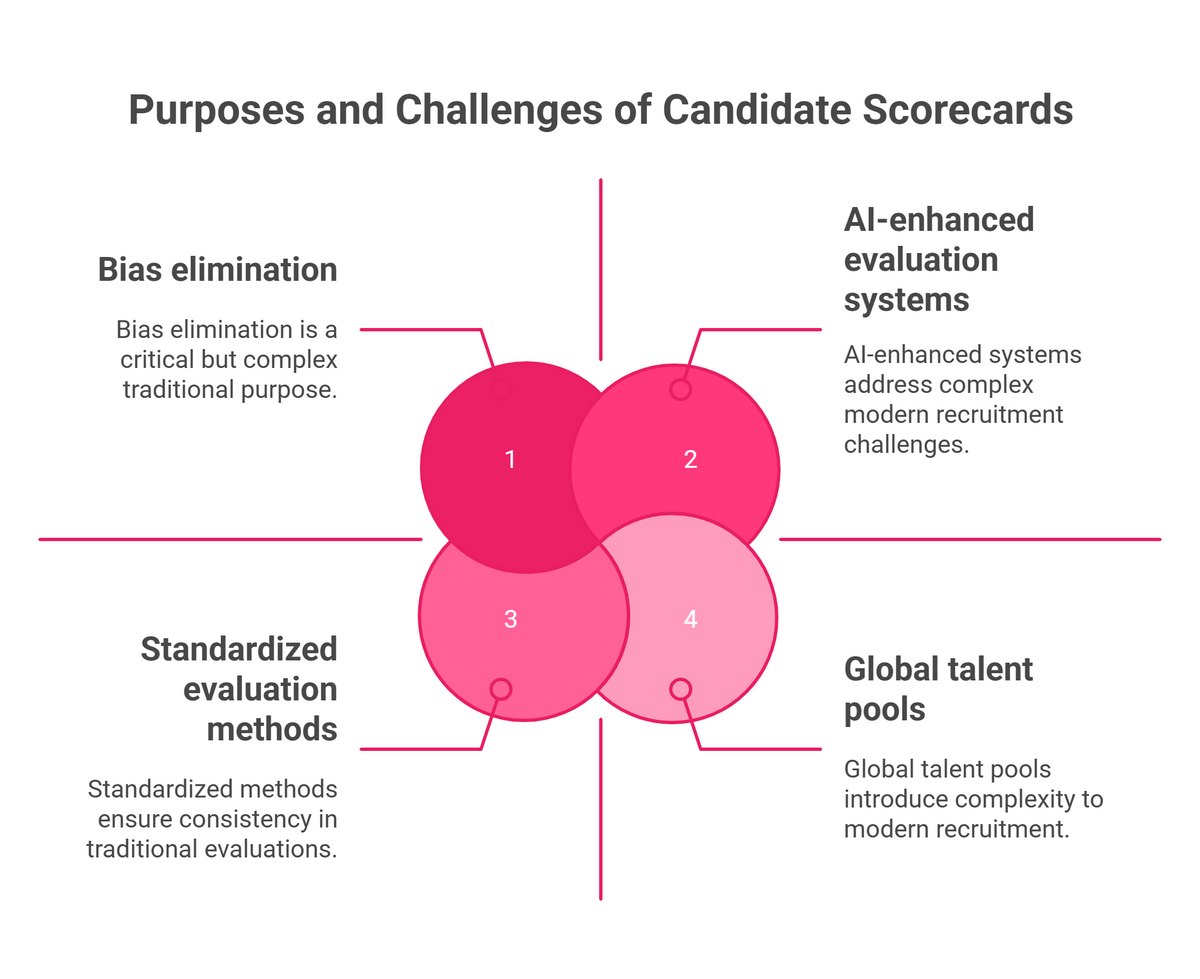
Understanding what a candidate scorecard is only scratches the surface. The real question is: why has virtually every Fortune 500 company adopted some form of structured candidate evaluation? The answer lies in the fundamental purposes these tools serve in modern recruitment.
Primary Purpose: Eliminating Bias and Ensuring Objectivity
The most critical purpose of candidate scorecards is bias elimination. Human decision-making, no matter how well-intentioned, is susceptible to unconscious preferences that can derail hiring quality and create legal liability.
Common biases that scorecards help combat include:
- Affinity Bias: Favoring candidates who share similar backgrounds, interests, or experiences
- Confirmation Bias: Seeking information that supports initial impressions while ignoring contradictory evidence
- Halo Effect: Allowing one impressive trait to overshadow weaknesses in other areas
- Recency Bias: Giving disproportionate weight to the most recently interviewed candidates
By establishing predetermined evaluation criteria, candidate scorecards force hiring teams to assess what truly matters for job success rather than what feels comfortable or familiar.
Consistency Across Interviewers and Interview Questions
Without standardized evaluation methods, hiring becomes a chaotic process where candidate success depends more on interviewer mood than actual qualifications. Research shows that different interviewers assessing the same candidate can reach wildly different conclusions when using unstructured approaches.
Candidate scorecards solve this by:
Standardizing Questions: Every candidate faces the same core questions, eliminating the randomness of conversational interviews where some applicants get softball questions while others face intense grilling.
Defining Success Metrics: Clear criteria for what constitutes a strong, average, or weak response removes subjective interpretation from the equation.
Creating Evaluation Templates: Interviewers know exactly what to look for and how to document their observations, leading to more thoughtful and consistent assessments.
Legal Compliance and Protection
The legal implications of inconsistent hiring practices extend far beyond inconvenience—they can result in discrimination lawsuits, EEOC investigations, and substantial financial penalties.
Candidate scorecards provide crucial legal protection by:
Documenting Decision Rationale: When hiring decisions are questioned, organizations can point to specific, job-related criteria that guided their choices rather than vague impressions or gut feelings.
Ensuring Equal Treatment: All candidates undergo identical evaluation processes, making it difficult to claim discriminatory treatment based on protected characteristics.
Creating Audit Trails: Structured scorecards generate data that can demonstrate pattern of fair hiring practices over time, providing evidence of good-faith efforts to maintain equitable processes.
Team Alignment and Collaborative Decision-Making
One of the most overlooked purposes of candidate scorecards is their ability to align diverse stakeholders around common hiring goals. When technical managers, HR professionals, and senior leadership all use the same evaluation framework, discussions become more productive and decisions more defensible.
Effective scorecards facilitate team alignment through:
Shared Language: Everyone discusses candidates using the same terminology and criteria, reducing misunderstandings and improving communication quality.
Weighted Priorities: Teams can agree upfront about which skills and attributes matter most, preventing end-of-process conflicts about candidate ranking.
Collaborative Scoring: Multiple evaluators can contribute input while maintaining consistency, leading to more comprehensive and accurate assessments.
Data-Driven Decisions Over Gut Feelings
Perhaps the most transformative purpose of candidate scorecards is their ability to replace intuition with evidence. Organizations that embrace data-driven hiring consistently outperform those relying on traditional approaches.
The shift from gut feelings to measurable criteria enables:
Performance Prediction: Companies can track correlations between scorecard results and subsequent job performance, continuously refining their evaluation criteria.
Process Improvement: Hiring teams can analyze patterns in their scoring to identify bottlenecks, biases, or ineffective questions.
ROI Measurement: Clear metrics make it possible to calculate the financial impact of hiring decisions and optimize recruitment investments.
The Modern Challenge: Volume and Complexity In Providing Interview Feedback
While traditional candidate scorecards address many fundamental hiring challenges, they struggle with the realities of modern recruitment. Today's organizations often process hundreds of applications for single positions, making manual scorecard completion time-prohibitive.
Contemporary hiring faces unique pressures:
Global Talent Pools: Remote work has expanded candidate searches worldwide, requiring evaluation methods that work across cultural and linguistic differences.
Asynchronous Communication: Video responses and digital portfolios provide richer candidate information but require new evaluation approaches that traditional scorecards can't handle effectively.
Speed Requirements: Competitive talent markets demand faster decision-making, yet thorough evaluation remains essential for quality hires.
These evolving challenges explain why forward-thinking organizations are adopting AI-enhanced evaluation systems that maintain scorecard structure while adding technological capabilities to handle modern recruitment complexity. Platforms that can process video responses, analyze communication patterns, and maintain scoring consistency at scale represent the natural evolution of the candidate scorecard concept.
Candidate Scorecard Templates & Examples
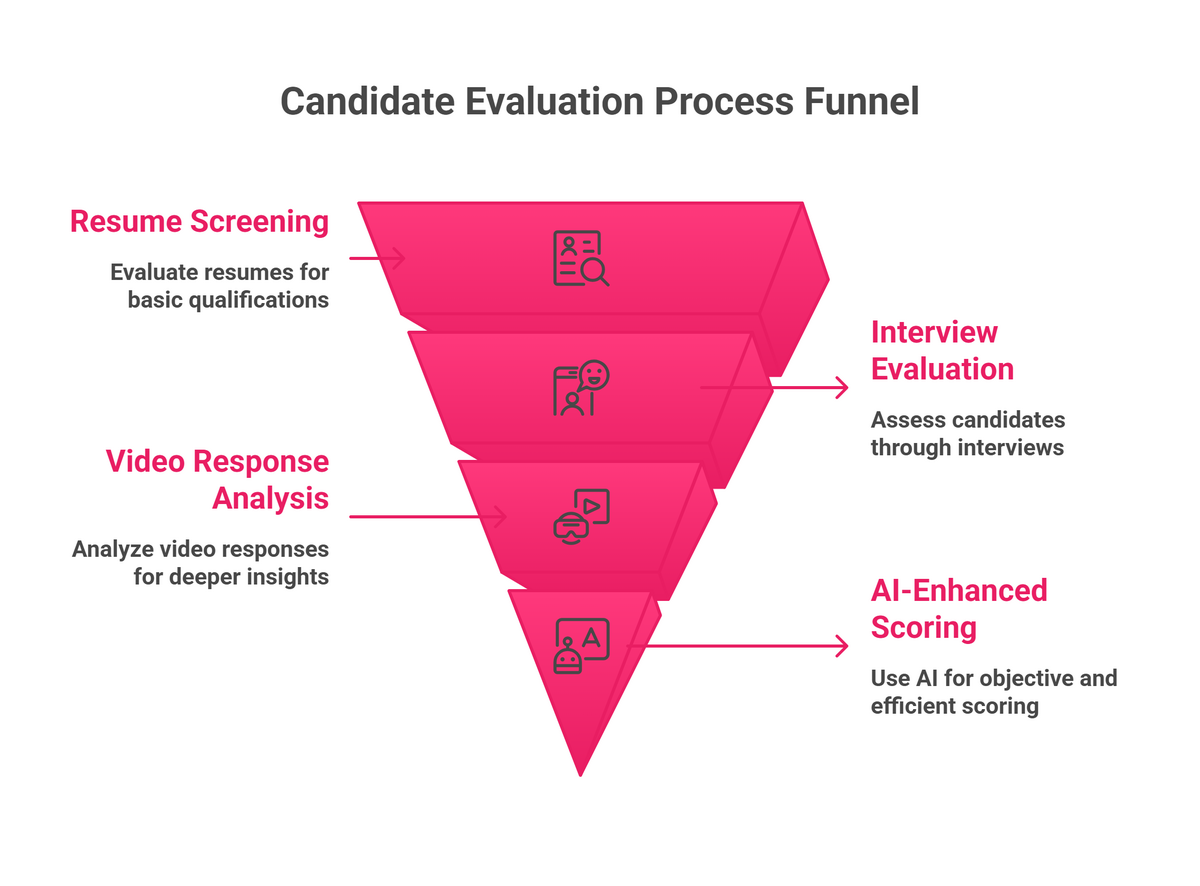
Theory means little without practical application. The most effective candidate scorecards translate abstract evaluation principles into concrete, actionable templates that hiring teams can immediately implement. Whether you're screening resumes, conducting live interviews, or evaluating video responses, the right template structure makes the difference between consistent, defensible hiring decisions and continued reliance on gut feelings.
Basic Interview Scorecard Template
Every effective candidate scorecard starts with a fundamental structure that can be adapted across roles and industries. This foundational template provides the framework for fair, comprehensive candidate evaluation.
Essential Template Components:
Candidate Information Section
- Name, position applied for, interview date
- Interviewer name(s) and role(s)
- Interview format (live, phone, video response)
Core Competency Evaluation (70% of total score)
- Job-specific technical skills (40% weight)
- Problem-solving and analytical thinking (20% weight)
- Communication and collaboration (10% weight)
Cultural Fit Assessment (20% of total score)
- Alignment with company values
- Team integration potential
- Growth mindset and adaptability
Additional Considerations (10% of total score)
- Relevant experience beyond minimum requirements
- Professional development initiatives
- Industry knowledge and awareness
Scoring Scale: 1-5 Points
- 5: Exceptional - Significantly exceeds expectations
- 4: Strong - Exceeds expectations in most areas
- 3: Satisfactory - Meets all expectations
- 2: Developing - Meets some expectations, gaps evident
- 1: Unsatisfactory - Does not meet expectations
Documentation Requirements
- Specific examples supporting each score
- Direct quotes or behavioral observations
- Areas for follow-up or clarification
- Overall recommendation with rationale
Role-Specific Scorecard Examples
Different positions require tailored evaluation criteria that reflect the unique demands and success factors of each role. Generic scorecards often miss critical competencies while overemphasizing irrelevant skills.
Technical Roles Scorecard
For software developers, engineers, and technical specialists:
Technical Competency (50% weight)
- Programming language proficiency
- System design and architecture understanding
- Debugging and problem-solving approach
- Code quality and best practices knowledge
Problem-Solving Methodology (25% weight)
- Approach to breaking down complex problems
- Ability to explain technical concepts clearly
- Creative thinking and innovation potential
- Learning agility with new technologies
Collaboration Skills (15% weight)
- Code review participation and feedback quality
- Cross-functional communication effectiveness
- Mentoring and knowledge-sharing willingness
- Team project contribution style
Professional Growth (10% weight)
- Continuous learning initiatives
- Industry trend awareness
- Personal project involvement
- Technical community participation
Leadership Position Scorecard
For managers, directors, and executive roles:
Strategic Thinking (30% weight)
- Long-term vision development and communication
- Market and competitive landscape understanding
- Resource allocation and prioritization skills
- Change management and adaptation capability
People Leadership (35% weight)
- Team motivation and engagement strategies
- Conflict resolution and difficult conversation handling
- Talent development and succession planning
- Inclusive leadership and diversity promotion
Execution Excellence (25% weight)
- Goal setting and performance measurement
- Process optimization and efficiency improvement
- Cross-departmental collaboration facilitation
- Results delivery under pressure
Communication Impact (10% weight)
- Executive presence and influence
- Stakeholder management across levels
- Public speaking and presentation skills
- Written communication clarity and persuasion
Sales Team Scorecard
For sales representatives, account managers, and business development roles:
Sales Methodology (40% weight)
- Lead qualification and pipeline management
- Consultative selling approach demonstration
- Objection handling and negotiation skills
- Closing techniques and deal progression
Relationship Building (30% weight)
- Rapport establishment and trust building
- Customer needs discovery and active listening
- Long-term relationship maintenance strategies
- Networking and referral generation ability
Results Orientation (20% weight)
- Goal achievement and quota attainment history
- Performance consistency and predictability
- Competitive drive and resilience demonstration
- Territory or account growth potential
Product Knowledge (10% weight)
- Company offering understanding depth
- Competitive landscape awareness
- Value proposition articulation clarity
- Technical specification communication ability
Resume Screening Scorecard Template
Before any interview occurs, resume screening provides the first candidate evaluation opportunity. A structured approach to resume review ensures qualified candidates advance while preventing unconscious bias from eliminating strong prospects.
Education and Credentials (20% weight)
- Relevant degree or certification completion
- Educational institution reputation and rigor
- Continuing education and professional development
- Industry-specific certification maintenance
Experience Relevance (40% weight)
- Years of directly applicable experience
- Progressive responsibility and career growth
- Industry experience alignment
- Company size and complexity similarity
Skills and Competencies (25% weight)
- Technical skill proficiency based on stated requirements
- Software and tool familiarity
- Language capabilities when relevant
- Specialized knowledge areas
Career Progression (15% weight)
- Job tenure and stability patterns
- Advancement and promotion history
- Scope and responsibility expansion
- Leadership and project management experience
Red Flag Assessment
- Employment gaps requiring explanation
- Frequent job changes without clear progression
- Overqualification or underqualification concerns
- Geographic or compensation misalignment
Video Response Evaluation Templates
Asynchronous video interviews require specialized evaluation approaches that account for the unique advantages and challenges of recorded responses. Traditional scorecard criteria must adapt to effectively assess video content while maintaining fairness across different communication styles.
Hirevire-Optimized Evaluation Framework:
Content Quality and Completeness (40% weight)
- Question comprehension and direct response
- Depth of explanation and detail provision
- Relevant example inclusion and specificity
- Key concept coverage and accuracy
Communication Effectiveness (30% weight)
- Message clarity and logical organization
- Professional presentation and engagement
- Confidence and authenticity demonstration
- Appropriate pace and articulation
Technical Presentation (15% weight)
- Video and audio quality optimization
- Professional environment and appearance
- Technology comfort and competence
- Recording preparation and thoughtfulness
Cultural and Soft Skills (15% weight)
- Company value alignment demonstration
- Team collaboration potential indicators
- Problem-solving approach explanation
- Growth mindset and learning orientation
AI-Enhanced Scoring Capabilities
Modern platforms like Hirevire transform traditional scorecard evaluation through intelligent analysis that maintains human insight while adding technological precision:
Automated Transcript Analysis: AI reviews spoken content for keyword relevance, concept coverage, and response completeness across 90+ languages, ensuring non-native speakers receive fair evaluation.
Communication Pattern Recognition: Systems identify clear communication structures, logical flow, and message coherence without penalizing individual speaking styles or cultural communication differences.
Objective Consistency Maintenance: AI scoring reduces human evaluator fatigue and bias by applying identical criteria to every response, while flagging responses that require human review for nuanced assessment.
Bulk Processing Efficiency: Large-scale candidate evaluation becomes feasible through automated initial scoring, allowing human reviewers to focus on borderline candidates and final decision-making.
Custom Evaluation Criteria: Organizations can define specific keywords, concepts, or competencies that AI should prioritize during evaluation, tailoring automated scoring to unique role requirements.
Implementation Best Practices
Successful scorecard implementation requires careful attention to setup and ongoing calibration. The most effective templates evolve based on hiring outcomes and team feedback.
Template Customization Guidelines:
- Start with proven frameworks and adapt gradually
- Weight criteria based on actual job performance data
- Include both hard skills and cultural fit assessment
- Regularly review and update based on hiring success rates
Team Training Requirements:
- Ensure all evaluators understand scoring definitions
- Practice with sample candidates to calibrate expectations
- Establish clear escalation procedures for borderline scores
- Create feedback loops for continuous improvement
Quality Assurance Measures:
- Compare scores across multiple evaluators for consistency
- Track correlation between scorecard results and job performance
- Analyze scoring patterns for potential bias indicators
- Adjust templates based on measurable outcomes
The evolution from paper-based forms to AI-enhanced evaluation represents more than technological advancement—it's a fundamental shift toward fairer, more effective hiring that serves both candidates and organizations better.
Traditional Scorecards vs. AI-Powered Scoring
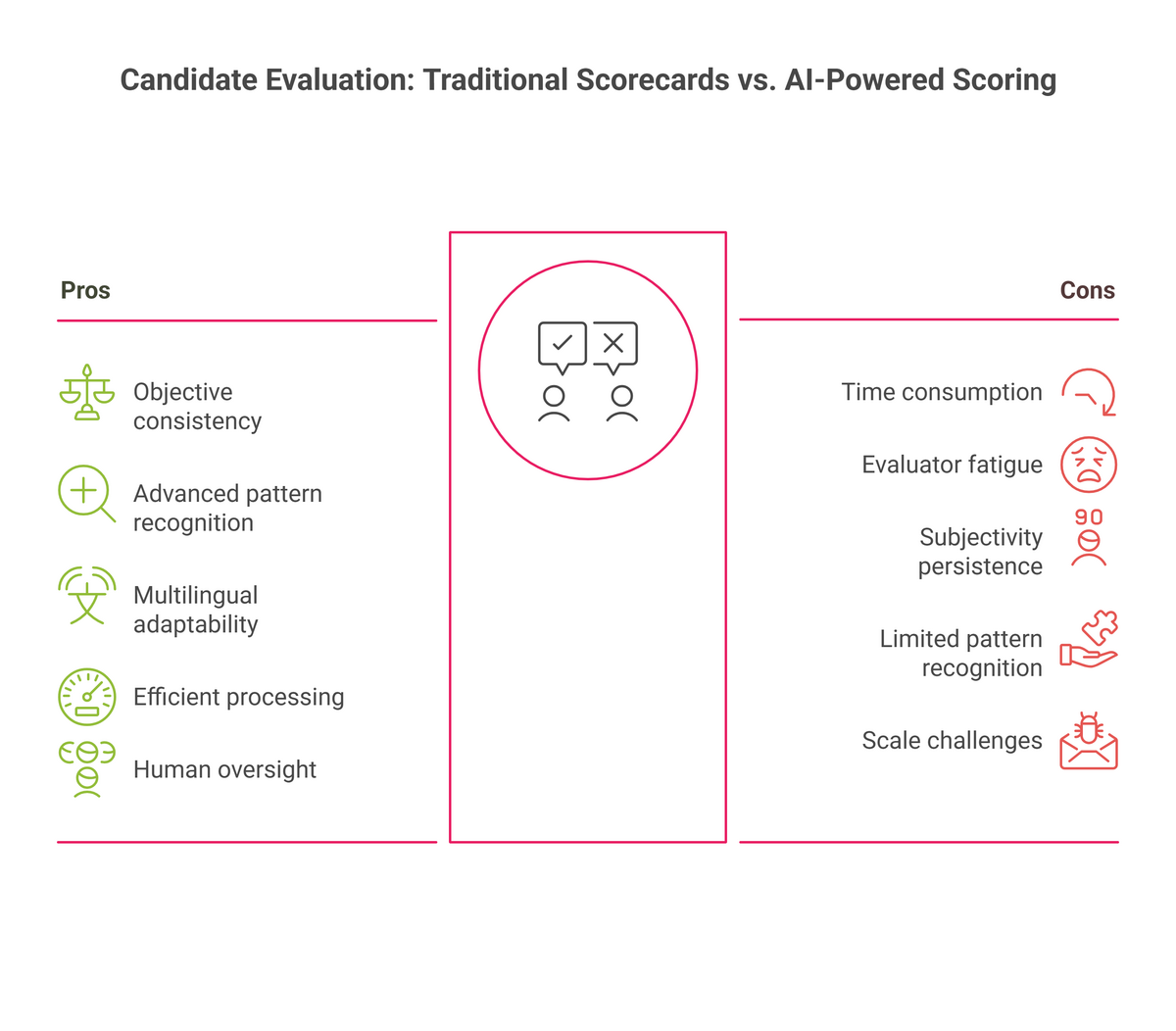
The hiring landscape has reached a critical inflection point. While traditional candidate scorecards provided structure to an otherwise chaotic process, they're proving inadequate for the demands of modern recruitment. Organizations processing hundreds of applications weekly are discovering that manual scoring creates more bottlenecks than solutions.
Limitations of Manual Scoring Systems
Traditional scorecard implementation suffers from fundamental human limitations that become magnified as hiring volume increases.
Time Consumption and Evaluator Fatigue
Manual scorecard completion demands significant time investment. HR managers spend 30-40% of their work week on screening activities, with each candidate evaluation requiring 20-30 minutes of focused attention. As evaluation sessions extend, scoring quality deteriorates due to decision fatigue—mental energy depletion that leads to shortcuts and inconsistent criteria application.
Inconsistent Application of Criteria
Despite clear rubrics and training, human evaluators interpret scoring guidelines differently. Research shows the same candidate response can receive ratings varying by two full points when assessed by different team members. This variation stems from individual experiences, mood fluctuations, and personal communication style preferences.
Subjectivity Persistence
Traditional scorecards reduce but don't eliminate subjective judgment. Evaluators often rationalize scores to match initial impressions, finding evidence to support gut feelings rather than objectively applying criteria. The "halo effect" remains particularly problematic—strong performance in one area influences ratings across unrelated competencies.
Limited Pattern Recognition
Human evaluators struggle to identify subtle patterns across large candidate pools. Important insights about communication styles or cultural fit indicators often emerge only when examining dozens of responses collectively—an analysis that manual processes make impractical.
The Volume Challenge in Modern Recruitment
Today's hiring environment presents scale challenges that traditional scorecards simply cannot handle effectively.
Scale Overwhelms Manual Processes
Growing companies frequently receive 200-500 applications for single positions. Manual scorecard evaluation of this volume would require 100+ hours of reviewer time per position—an impossible resource allocation for most organizations.
Competitive Time Pressures
Top candidates often consider multiple opportunities simultaneously, expecting feedback within days rather than weeks. Traditional scorecard processes, requiring coordination among multiple evaluators and manual compilation of results, cannot deliver the necessary speed to compete for high-demand talent.
Quality vs. Speed Trade-offs
Manual processes force organizations to choose between thorough evaluation and rapid response. Most companies compromise by reducing scorecard complexity or limiting evaluators, sacrificing assessment quality for operational feasibility.
The AI Revolution in Candidate Evaluation
Artificial intelligence addresses manual scoring limitations while introducing capabilities impossible with traditional approaches.
Objective Consistency at Scale
AI-powered evaluation applies identical criteria to every candidate response, eliminating human mood variations, fatigue effects, and unconscious bias influences. Machine learning algorithms process hundreds of responses in minutes while maintaining analytical rigor throughout.
Advanced Pattern Recognition
AI systems identify communication patterns, keyword usage, and concept relationships that human evaluators often miss. These systems recognize when candidates demonstrate competencies through different communication styles or cultural approaches, providing more inclusive evaluation processes.
Multilingual and Cultural Adaptability
Modern AI transcription and analysis handle global candidate pools effectively, processing responses in dozens of languages while accounting for cultural communication differences. This capability enables truly global talent acquisition without language barriers affecting evaluation quality.
Hirevire's AI Review Process Deep Dive
Hirevire exemplifies the AI-powered evaluation revolution through sophisticated analysis capabilities that maintain human insight while adding technological precision.
Advanced Transcript Analysis
Hirevire's AI processes video and audio responses using natural language processing that operates across 90+ languages. The system generates accurate transcripts regardless of accent, speaking pace, or background noise, ensuring no candidate faces disadvantages due to technical factors or linguistic variations.
The transcript analysis goes beyond simple speech-to-text conversion. Advanced algorithms identify key concepts, technical terminology, and relevant experience indicators mentioned in responses, creating comprehensive content maps that human evaluators can review efficiently.
Intelligent Keyword Identification
The platform employs semantic analysis to recognize when candidates address required competencies through different vocabulary or communication approaches. Rather than searching for exact keyword matches, the AI understands contextual meaning and concept relationships.
For example, when evaluating leadership experience, the system recognizes phrases like "guided the team through challenges," "coordinated project deliverables," and "mentored junior colleagues" as equivalent leadership indicators, despite different terminology.
Custom Evaluation Criteria Integration
Organizations can define specific evaluation prompts (up to 200 characters) that guide AI analysis toward role-relevant competencies. These custom criteria enable tailored evaluation while maintaining consistency and efficiency benefits of automated scoring.
Match/Non-Match Insights with Reasoning
Hirevire's AI provides detailed explanations for evaluation decisions. Rather than simply assigning scores, the system identifies specific response elements that led to match or non-match determinations, enabling human reviewers to understand and validate AI recommendations.
Bulk Processing Capabilities
The platform processes dozens of candidate responses simultaneously, providing comprehensive evaluation reports that would require days of manual effort. This capability enables organizations to maintain thorough assessment standards while meeting competitive timing requirements.
Quality Assurance and Human Oversight
AI-powered scoring doesn't eliminate human judgment—it enhances and focuses it. Hirevire's system flags responses requiring human review while providing objective initial assessments that help evaluators allocate time effectively.
The transition from manual scorecards to AI-enhanced evaluation represents a fundamental shift toward fairer, more effective hiring. As recruitment continues evolving toward global, remote, and high-volume operations, AI-powered evaluation becomes essential for competitive talent acquisition.
How Hirevire Transforms Candidate Scoring
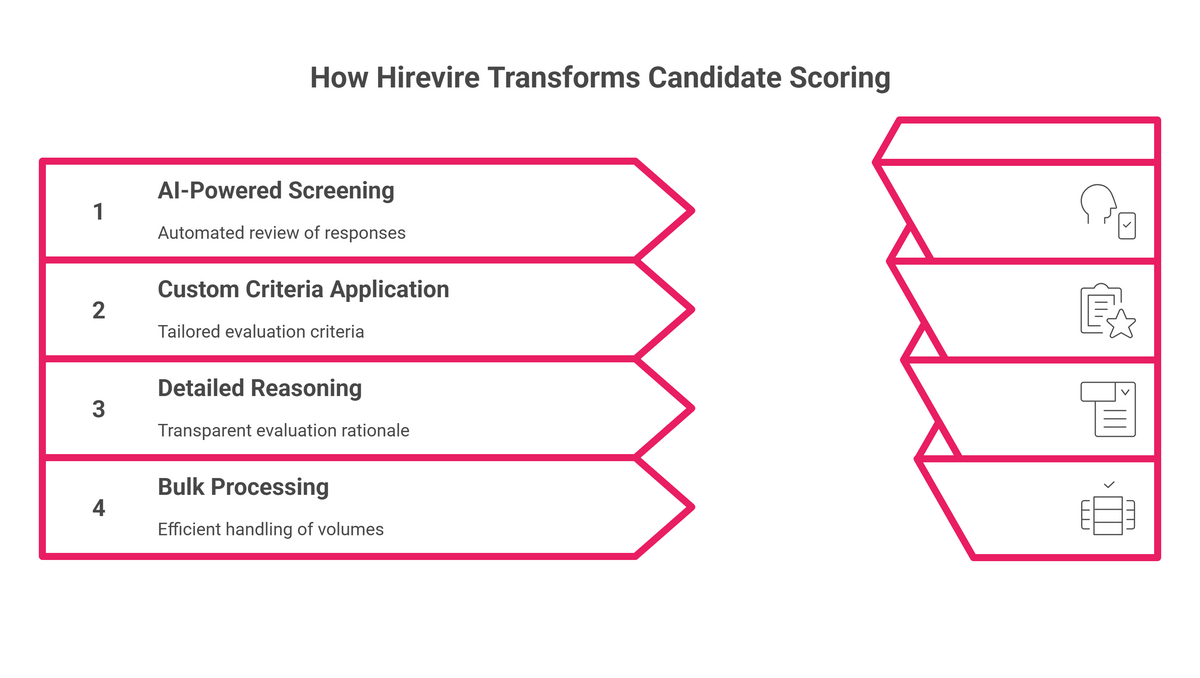
When a growing fintech company faced screening 400+ applications for a single developer position, they processed the entire candidate pool in under 48 hours using Hirevire's AI-powered scoring system. This transformation represents a fundamental reimagining of how candidate assessment works in modern recruitment. Moreover, the competitive $39 introductory pricing also gives an edge to the high-performing tool.
Automated AI Reviews for Video and Audio Responses
Hirevire's automated review system eliminates manual video evaluation bottlenecks while providing deeper insights than human reviewers can consistently deliver.
Multi-Format Processing Excellence
The AI review engine handles various response formats seamlessly. Video responses receive comprehensive analysis including verbal content, presentation skills, and professional demeanor assessment. Audio-only responses undergo focused analysis on communication clarity, thought organization, and subject matter expertise. Text submissions and file uploads integrate into the unified evaluation framework.
Real-Time Transcript Generation
As candidates submit responses, Hirevire's AI generates accurate transcripts that capture meaning and context. The system distinguishes between technical terminology and conversational language, ensuring specialized knowledge receives appropriate recognition.
Contextual Understanding
Unlike simple keyword matching systems, Hirevire's AI comprehends candidate responses within proper context. When a software developer mentions "debugging a complex authentication issue," the system understands this demonstrates both technical problem-solving skills and experience with security systems, even without explicit use of terms like "troubleshooting" or "cybersecurity."
Key Focus Areas: Comprehensive Response Analysis
Hirevire's AI evaluation centers on three critical dimensions that predict candidate success while maintaining fairness across different communication styles and cultural backgrounds.
Keyword Identification and Relevance
The platform employs advanced semantic analysis to identify relevant keywords and concepts within candidate responses. Rather than requiring exact phrase matches, the AI recognizes equivalent expressions and industry-specific terminology variations.
When evaluating project management experience, the system identifies phrases like "coordinated cross-functional teams," "managed deliverable timelines," "facilitated stakeholder alignment," and "drove project completion" as equivalent indicators of project management capability. This semantic understanding ensures candidates aren't penalized for using different vocabulary to describe similar experiences.
The AI also weights keyword relevance based on role requirements. Technical keywords receive higher importance for engineering positions, while leadership terminology gains priority for management roles.
Answer Completeness Assessment
Hirevire's AI evaluates whether candidates fully address question components, providing comprehensive assessment of response thoroughness. The system identifies when candidates provide examples, explain reasoning, discuss outcomes, and connect experiences to role requirements.
The completeness analysis considers cultural communication differences, recognizing that candidates provide direct answers or detailed narratives. The AI adapts evaluation criteria to ensure neither communication style receives unfair advantage.
Communication Clarity Evaluation
The platform assesses how effectively candidates convey their thoughts, regardless of native language or accent. Clarity evaluation encompasses logical flow, idea organization, and message coherence rather than perfect grammar or pronunciation.
Hirevire's AI distinguishes between communication challenges caused by technical issues and actual clarity concerns. Candidates facing technical difficulties don't receive lower clarity scores, ensuring fair evaluation across varying recording conditions.
Custom Evaluation Criteria: Tailored Scoring Framework
Organizations can customize Hirevire's AI evaluation through specific prompts that guide analysis toward role-relevant competencies while maintaining automated efficiency.
200-Character Prompt System
Hirevire enables organizations to define custom evaluation criteria using concise prompts of up to 200 characters. These prompts direct the AI to focus on specific competencies, experiences, or qualities most relevant to particular roles.
Example custom prompts include:
- "Evaluate experience with agile development methodologies and cross-functional collaboration"
- "Assess leadership examples involving conflict resolution and team motivation"
- "Identify customer service skills including problem-solving and empathy demonstration"
Dynamic Criteria Weighting
Organizations can assign importance weights to different evaluation areas. Technical roles might emphasize problem-solving prompts at 40% while communication receives 20%. Sales positions could reverse this weighting, prioritizing relationship-building and persuasion skills.
Industry-Specific Adaptations
The custom criteria system accommodates industry-specific requirements. Healthcare organizations can prioritize patient care experience, while financial services companies can emphasize risk management capabilities.
Match/Non-Match Insights with Detailed Reasoning
Hirevire's AI provides transparent evaluation rationale that enables human reviewers to understand and validate automated recommendations.
Comprehensive Decision Explanations
For each candidate evaluation, the AI generates detailed explanations outlining specific response elements that influenced match or non-match determinations. These explanations reference actual candidate statements, identified keywords, and completeness assessments that contributed to overall scoring.
Evidence-Based Recommendations
Rather than providing simple pass/fail verdicts, Hirevire's system highlights candidate strengths and development areas with supporting evidence. A software developer might receive high marks for technical problem-solving based on specific debugging examples they shared, while noting opportunities for improvement in project management experience.
Human Review Integration
AI insights integrate seamlessly with human reviewer workflows. Hiring managers can quickly understand AI reasoning, add their own observations, and make final decisions based on comprehensive candidate profiles that combine automated analysis with human judgment.
Bulk Processing: Scale Without Compromise
Hirevire's bulk processing capabilities enable organizations to maintain rigorous evaluation standards while handling candidate volumes that would overwhelm traditional approaches.
Simultaneous Multi-Candidate Analysis
The platform processes dozens of candidate responses concurrently, applying identical evaluation criteria across the entire applicant pool. This simultaneous analysis ensures consistent scoring standards while delivering results in hours rather than days or weeks.
Automated Ranking and Filtering
Beyond individual evaluations, Hirevire automatically ranks candidates based on overall scores and custom criteria weightings. Organizations can set minimum thresholds for advancement, automatically filtering candidates while maintaining detailed records for compliance and feedback purposes.
Integration with Existing Workflows
Bulk processing results integrate with existing ATS systems and hiring workflows through APIs and data exports. This integration enables seamless transition from automated screening to human interview processes without duplicating effort or losing evaluation insights.
The transformation Hirevire brings to candidate scoring represents a fundamental shift toward fairer, more efficient hiring that serves both candidates and organizations better. By combining AI precision with human insight, the platform enables organizations to compete effectively for top talent while maintaining thorough evaluation standards.
| Traditional Scorecards | Hirevire AI-Powered |
|---|---|
| Manual video review (20-30 min/candidate) | Automated analysis (2-3 min/candidate) |
| Subjective interpretation | Consistent AI evaluation |
| Single language evaluation | 90+ language support |
| Individual candidate processing | Bulk processing capabilities |
| Basic notes and ratings | Detailed reasoning with evidence |
| Evaluator fatigue affects quality | Consistent quality at scale |
Implementation Guide: Setting Up Fair Candidate Scoring
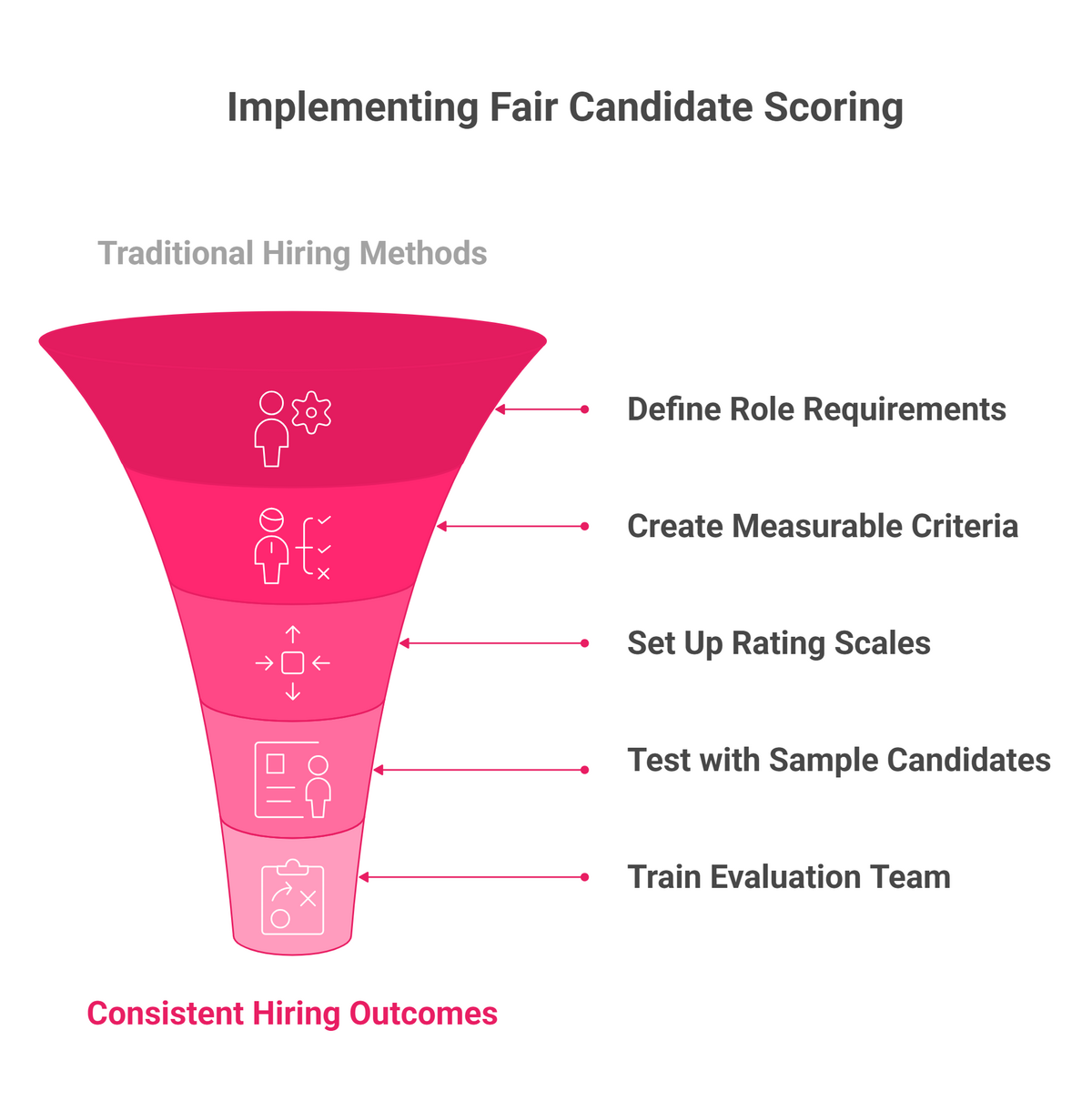
Most of the hiring managers share how they make significant mistakes while implementing AI automation in recruitment. Moving from traditional hiring methods to structured candidate scoring requires careful planning and systematic implementation. Success depends on methodical setup, comprehensive team preparation, and clear workflow integration.
Step-by-Step Scorecard Creation
Effective candidate scorecard implementation follows a proven five-phase approach.
Phase 1: Define Role Requirements
Conduct detailed job analysis identifying specific skills, knowledge areas, and competencies essential for role success. Interview current high performers to understand what distinguishes excellent from adequate performance. Create competency hierarchies that distinguish between must-have qualifications and preferred attributes.
Phase 2: Create Measurable Criteria
Transform competency requirements into specific, observable behaviors. Instead of "good communication skills," define measurable indicators like "clearly explains technical concepts to non-technical stakeholders." Establish clear performance levels using 3-5 point scales with detailed descriptions.
Phase 3: Set Up Rating Scales and Weights
Assign importance weights to different competency areas based on job performance impact. Technical roles might weight problem-solving at 40% while communication receives 20%. Test weighting scenarios using data from previous successful hires.
Phase 4: Test with Sample Candidates
Pilot your scorecard system with archived candidate materials or volunteers. This reveals ambiguous criteria and rating inconsistencies. Multiple evaluators should reach similar conclusions when assessing identical responses.
Phase 5: Train Evaluation Team
Conduct training covering scorecard mechanics, bias recognition, and consistent application techniques. Use real examples to demonstrate proper scoring and discuss challenging edge cases.
Best Practices for Bias Reduction
Use identical questions for all candidates within the same role category. Develop behavioral questions focused on job-relevant scenarios rather than general background discussions.
Maintain consistent scoring standards through detailed rubrics defining performance levels objectively. Implement blind review processes where possible.
Require multiple team members to evaluate each candidate independently before comparing scores. This reveals bias patterns and improves assessment accuracy.
Team Training and Calibration
Provide comprehensive instruction on scorecard mechanics and bias recognition. Practice evaluation exercises using standardized examples help develop consistent interpretation approaches.
Conduct regular calibration meetings where team members discuss scoring decisions and resolve interpretation differences. Review challenging cases collectively to establish precedents.
Hirevire Workflow: From Video Creation to AI Scoring
Create customized video interview experiences reflecting your organization's brand. Configure custom evaluation criteria using 200-character prompts that guide AI analysis toward role-specific requirements.
Automated email workflows guide candidates through the video response process. The no-login system reduces friction while maintaining professional presentation.
Hirevire's AI processes video responses immediately upon submission, generating comprehensive evaluations based on custom criteria. Automated ranking helps prioritize candidates while maintaining detailed compliance records.
Organizations implementing these systematic approaches achieve more consistent, fair, and effective hiring outcomes.
Advanced Scoring Strategies
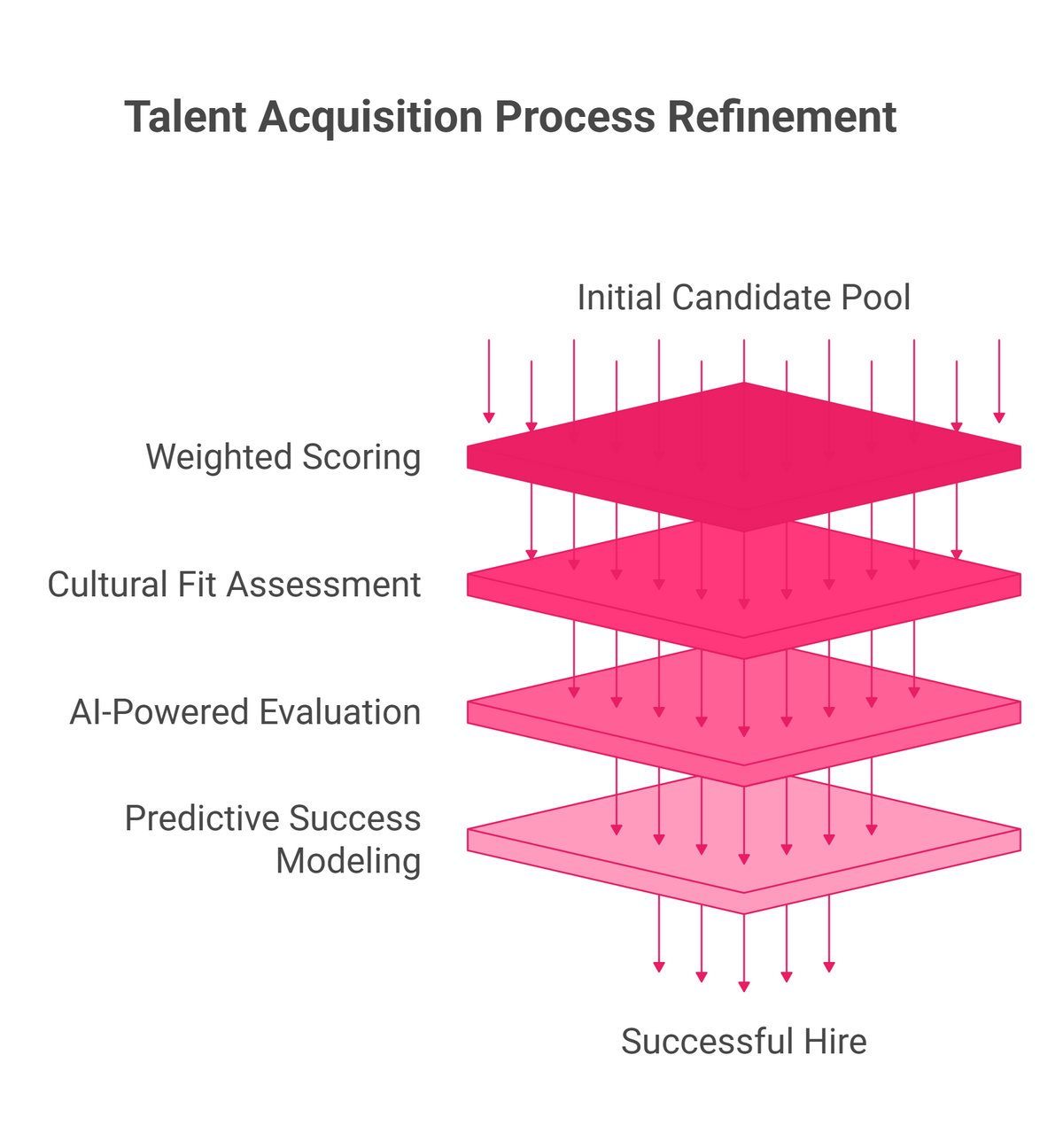
Advanced scoring strategies leverage weighted methodologies, cultural alignment assessment, and AI capabilities for competitive talent acquisition.
Weighted Scoring Methods
Strategic weighting transforms evaluation into role-specific assessment.
Dynamic Competency Weighting
Different roles require different competency emphasis. Software engineering positions allocate 50% weight to technical problem-solving, 25% to code quality, 15% to collaboration, and 10% to communication. Sales roles emphasize relationship building (40%), communication (30%), results orientation (20%), and technical knowledge (10%).
Organizations track correlations between scorecard results and job performance, refining weightings for improved accuracy.
Situational Weight Adjustments
Advanced systems modify weightings based on team needs. Development teams lacking senior mentors increase leadership weights for new hires. Rapidly growing companies emphasize adaptability over deep specialization.
Performance-Based Calibration
Sophisticated approaches analyze historical hiring data to identify which competencies predict success in specific roles, eliminating guesswork and creating accurate candidate ranking.
Cultural Fit Assessment
Cultural alignment determines long-term hire success, yet traditional scorecards struggle with objective cultural evaluation.
Values-Based Evaluation Framework
Advanced cultural assessment focuses on behavioral evidence rather than personality matching. Evaluators seek specific examples reflecting organizational values.
For innovation-focused companies, cultural evaluation assesses risk-taking comfort and experimentation willingness. Collaborative organizations emphasize team-first mentality and knowledge-sharing enthusiasm.
Behavioral Indicator Mapping
Sophisticated assessment maps company values to specific behavioral indicators. "Customer obsession" translates into evidence of going beyond requirements to solve problems or seeking feedback to improve solutions.
Team Dynamic Consideration
Advanced approaches consider contribution to team balance. Analytical teams might benefit from creative perspectives, while risk-taking groups need members who consider potential downsides.
Future Developments in AI Evaluation
AI-powered assessment evolution captures subtle indicators previously impossible to measure.
Enhanced Natural Language Processing
Next-generation AI will understand context and communication nuances with human-level sophistication. Systems will recognize leadership potential in language choices, identify problem-solving approaches through explanation patterns, and assess emotional intelligence through response styles.
Predictive Success Modeling
Advanced AI will analyze patterns across successful employees to predict candidate performance with unprecedented accuracy. Machine learning algorithms will identify non-obvious correlations between communication styles and job success rates.
Behavioral Pattern Recognition
Future AI evaluation will assess behavioral consistency across multiple response formats, identifying candidates whose actions align with stated values and approaches.
Real-Time Adaptation
Emerging systems will adjust evaluation criteria dynamically based on performance feedback, ensuring assessment evolves with changing organizational needs.
Hirevire Roadmap: Expanding AI Capabilities
Hirevire's roadmap reflects industry evolution toward comprehensive AI assessment maintaining human insight while expanding capabilities.
Text Response Analysis
Hirevire’s features include sophisticated written response analysis complementing video evaluation. Advanced natural language processing will assess writing quality, logical reasoning, and technical knowledge through text submissions.
Document Analysis Integration
Future capabilities will analyze portfolios, code samples, and work artifacts using AI that understands context and quality indicators. This enables comprehensive skill assessment beyond interview responses.
Enhanced Cultural Assessment
Planned developments include AI systems identifying cultural alignment indicators through communication patterns, value demonstration, and behavioral consistency across response formats.
Predictive Analytics Enhancement
Advanced analytics will correlate candidate assessment results with long-term performance outcomes, continuously improving evaluation accuracy and providing hiring success pattern insights.
Integration Ecosystem Expansion
Future development focuses on seamless HR technology integration, creating comprehensive assessment workflows spanning screening through performance management.
These strategies represent evolution from basic screening toward predictive talent intelligence.
The Bottom Line
The evolution from gut-feeling hiring to structured candidate scorecards represents a fundamental shift toward fairer, more effective talent acquisition.
Summary of Key Benefits
Candidate scorecards eliminate the 85-97% of hiring decisions based on subjective impressions, replacing bias with objective evaluation criteria. Organizations implementing structured scoring achieve 40-60% reduction in time-to-hire and significantly improved quality of hire metrics.
Traditional scorecards provide structure, but manual processes cannot handle modern recruitment demands. High-volume hiring and competitive time pressures require technological enhancement that maintains quality while delivering speed.
AI-powered systems like Hirevire represent the natural evolution of candidate assessment, combining scorecard structure with intelligent analysis that processes video responses and provides detailed reasoning across 90+ languages.
The Modern Hiring Imperative
Today's competitive talent market demands both speed and quality—impossible with traditional manual processes. Poor hiring decisions cost up to five times an employee's annual salary, while inconsistent processes create legal liability.
Companies embracing AI-enhanced candidate scoring gain decisive advantages: faster decision-making, accurate assessment, reduced bias, and scalable processes.
Transform Your Candidate Evaluation Today
Ready to move beyond gut feelings? Hirevire's AI-powered candidate scoring transforms video interviews into comprehensive evaluations that identify top talent while maintaining fair assessment standards.
Frequently Asked Questions
What is the difference between a candidate scorecard and a regular interview evaluation?
A candidate scorecard uses predetermined criteria and standardized rating scales to assess candidates objectively, while regular evaluations rely on subjective impressions and unstructured feedback. Scorecards provide consistent frameworks that reduce bias and improve hiring decisions through evidence-based ratings.
Modern platforms like Hirevire enhance traditional scorecards with AI analysis that automatically evaluates video responses against custom criteria. This ensures every candidate receives identical assessment standards regardless of who conducts the evaluation. The result is more defensible hiring decisions based on job-relevant competencies rather than personal preferences.
How do candidate scorecards help reduce hiring bias?
Candidate scorecards establish objective evaluation criteria before meeting candidates, eliminating first impressions and personal preferences from decision-making.
They require specific behavioral evidence to support ratings and use standardized questions for all candidates.AI-powered systems like Hirevire further reduce bias by analyzing responses consistently across different accents and communication styles.
The platform ensures fair evaluation regardless of demographic factors or cultural backgrounds. This systematic approach replaces gut feelings with measurable competencies that predict actual job performance.
Can candidate scorecards be customized for different roles?
Yes, effective scorecards should be tailored to specific role requirements with different competency weights and evaluation criteria. Technical positions might emphasize problem-solving at 50% weight, while sales roles prioritize relationship-building abilities.
Hirevire allows organizations to create custom evaluation prompts up to 200 characters that guide AI analysis. These prompts ensure automated scoring aligns with actual job demands and performance predictors. Role-specific customization improves hiring accuracy by focusing evaluation on competencies that drive success in particular positions.
How long does it take to implement candidate scorecards?
Implementation typically takes 2-4 weeks depending on organization size and involves defining requirements, creating criteria, and training teams. The process includes establishing rating scales, testing with sample candidates, and ensuring consistent application across evaluators.
Platforms like Hirevire accelerate implementation by providing pre-built templates and automated workflows that can be customized quickly. Many organizations reduce setup time to just a few days while maintaining comprehensive evaluation capabilities. Proper implementation investment pays dividends through improved hiring consistency and reduced time-to-hire metrics.
What's the ROI of using structured candidate scorecards?
Organizations using candidate scorecards typically see 40-60% reduction in time-to-hire and 65-75% decrease in screening time per candidate. Financial benefits include reduced cost-per-hire, lower turnover rates, and decreased legal risks from inconsistent evaluation processes.
Hirevire users report additional benefits from bulk processing capabilities that enable thorough evaluation without proportional time increases. The platform processes dozens of responses simultaneously while maintaining rigorous assessment standards. Return on investment often exceeds 300% within the first year through improved hiring efficiency and quality.

